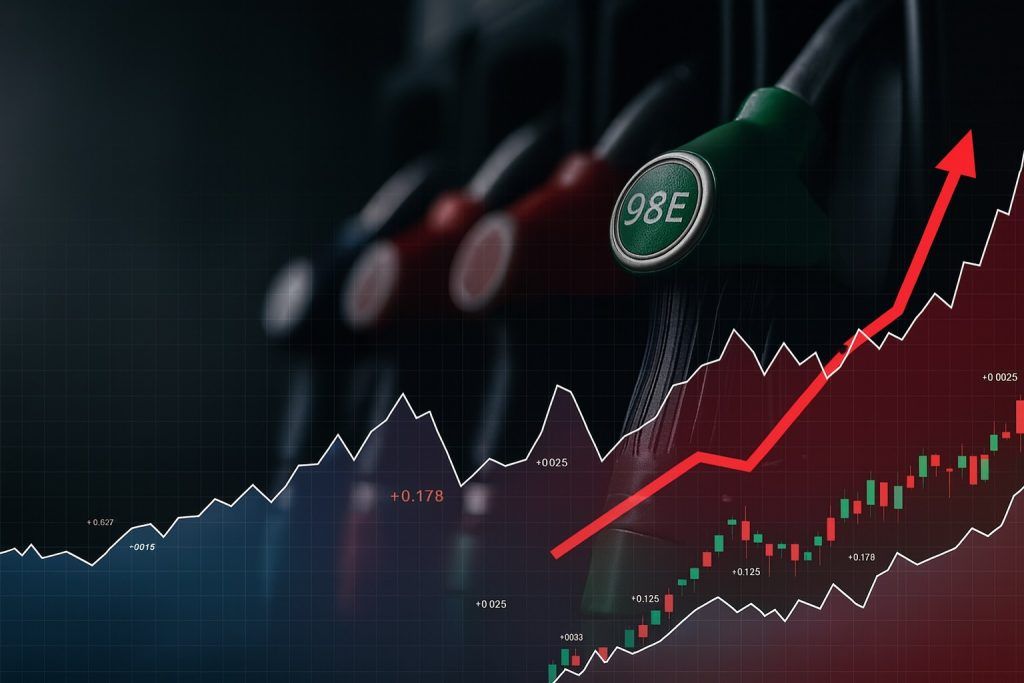- YDKG stock plunged ~90% in mid-October after a heavily dilutive $28 million funding deal, hitting a record low around $0.04 [1] [2].
- Rapid rebound: Shares have since rebounded to about $0.07–$0.09 as of Oct. 23, 2025, jumping ~60% from the lows amid speculative buying [3] [4].
- Dilution & shake-up: The collapse followed a massive share offering at $1 that nearly tripled the share count and a surprise CEO resignation on the same day [5] [6].
- Crypto pivot: Formerly AirNet Technology, Yueda Digital has pivoted to a Web3 crypto strategy – accumulating Bitcoin, Ethereum and other digital assets as a core business [7] [8].
- High-risk outlook: No major analysts cover YDKG, but AI models and market experts rate it a “Sell/Underperform” amid extreme volatility and fundamental concerns [9] [10].
Stock Price Carnage and Recent Rebound
Yueda Digital Holding’s stock (NASDAQ: YDKG) saw a stunning collapse in mid-October. Over an eight-day rout, shares cratered from around $3 to mere pennies, wiping out virtually all 2025 gains [11]. By October 20, YDKG closed at $0.043 – down ~98% in just ten trading days [12]. This plunge marked a new 52-week low (around $0.04) and erased a year’s worth of stock price appreciation [13]. Trading volume exploded during the sell-off as panicked investors rushed to exit; on Oct. 20, volume hit 128 million shares (vs. ~0.7 million typical), highlighting the frantic dumping of shares [14] [15].
In the days since hitting bottom, YDKG has staged a sharp bounce. The stock closed at $0.068 on Oct. 22 (up ~19% for the day) [16] and briefly traded around $0.09 in early pre-market on Oct. 23 [17]. From the $0.04 trough, YDKG has leapt roughly 60% in a “dead cat bounce.” However, shares remain ~90% below where they traded before the collapse and a staggering 99% off their 52-week high of $6.69 [18]. In other words, the recent uptick recovers only a tiny fraction of the prior loss. Analysts caution that such extreme volatility – daily swings over 20% and an eightfold spike in trading volume – underscores the stock’s highly speculative nature [19] [20].
Dilutive $28M Deal Triggers Sell-Off
The catalyst for Yueda’s crash was an October 15 financing announcement that blindsided investors. Yueda Digital revealed a $28 million registered direct offering of 28 million units at $1 each, with each unit consisting of one Class A share plus a warrant [21]. This meant new shares were being sold at a huge discount to the market price at the time (YDKG was trading near $3 before the news [22]). The dilutive impact was severe: the issuance was nearly 3× the company’s pre-deal market cap, dramatically expanding the share count [23]. Notably, the warrants carry extremely generous terms: they have a $1 exercise price but also a “zero-price” provision allowing conversion into shares for free [24]. According to SEC filings, warrant holders could claim up to 364 million additional shares at no cost, an almost unimaginable level of dilution for existing shareholders [25]. Even the company acknowledged it expects no cash proceeds from those warrant exercises – effectively giving away equity [26].
Unsurprisingly, the market reacted with panic. As soon as the funding deal was disclosed (and closed on Oct. 16 [27]), YDKG’s stock plunged over 85% intraday, entering a freefall [28]. Finimize, a financial newsletter, noted that “Yueda Digital’s plan to raise $28M… sparked an 86% plunge in its share price” as investors feared massive dilution [29]. By the end of that week, YDKG was down nearly 90%, showing how dilution fears can overwhelm any positive aspects of fresh capital [30]. The offering officially closed on Oct. 16, but at a terrible cost to shareholders.
Concurrently, leadership turmoil added to the uncertainty. On Oct. 15, Yueda’s board announced the resignation of CEO Dan Shao, architect of the company’s crypto pivot. The CFO, Baozhen Guo, was appointed as interim CEO the same day [31]. According to a TipRanks briefing, the change was positioned as a move for “long-term development,” yet it comes at a time of weakening revenues and rising costs [32]. Such a sudden management shake-up in a small, speculative firm further rattled investor confidence. In short, Yueda’s mid-October announcements – a heavily dilutive share sale and a CEO departure – created a perfect storm that sent the stock into an unprecedented tailspin.
Pivot to Crypto: Business Model & Recent Developments
Yueda Digital Holding is no ordinary media company now – it has radically rebranded and refocused as a crypto-centric holding firm. Until recently, the company operated as AirNet Technology (ticker ANTE), a Beijing-based provider of in-flight WiFi and advertising services. In September 2025, AirNet officially changed its name to Yueda Digital Holding (YDKG) to reflect a new strategic direction [33]. Yueda now bills itself as a “Web3 and digital-economy” company centered on cryptocurrency treasury management [34] [35].
In practice, this means Yueda is using the capital it raises to acquire and hold mainstream cryptocurrencies (like Bitcoin and Ethereum) for the long term. Management describes activities such as active crypto treasury management, staking and liquidity providing for yield, investing in Web3 infrastructure, and blockchain advisory services [36]. The goal, they say, is to “compound long-term value while supporting the growth of open blockchain networks” [37]. This essentially makes YDKG a niche crypto investment vehicle rather than a traditional operating business. For example, in September Yueda even received payment in Solana (SOL) tokens from a prior warrant exercise – about 296,367 SOL – boosting its digital asset holdings [38].
However, this bold crypto pivot has yet to translate into profits – in fact, the opposite. Financial results have deteriorated amid the transition. Simply Wall St. reports that Yueda swung to a net loss of $0.077 per share in the first half of 2025, versus a hefty profit of $2.66 per share in the same period a year prior [39]. Revenue did jump significantly (thanks to those new crypto-related ventures), but surging costs and heavy dilution have more than offset growth [40]. The company’s share count has ballooned from successive fundraises – including a huge $180 million offering in late August (prior to the recent $28M round) – which means any earnings are now spread across far more shares. With no traditional analysts covering YDKG, there’s scant formal guidance. But one thing is clear: Yueda’s fundamentals are now deeply in question. TipRanks’ AI-driven analysis flags “substantial declines in revenue, negative profitability, and a troubling balance sheet”, rating the stock as Underperform on a fundamental basis [41].
What Market Observers and Analysts Say
Given Yueda Digital’s tiny size and unconventional strategy, few Wall Street analysts have weighed in – but financial commentators are raising red flags. Technical analysis models are uniformly bearish. StockInvest.us, which tracks short-term trading signals, designated YDKG a “Strong Sell” during the collapse, warning the stock “may perform very badly in the next couple of days” [42]. Even after the small rebound, the service noted the absence of any support levels and extreme volatility, underscored by a 48.9% average daily swing over the past week [43] [44]. The recent bounce hasn’t changed the bleak picture much – on Oct. 22, StockInvest actually upgraded YDKG from “Sell” to “Hold/Accumulate” only on the basis that it was extremely oversold (RSI ~12) and could see a technical re-bound in the short term [45] [46]. In other words, the stock is such a speculative flyer that even a hold rating is based on the chance of a quick tradeable uptick, not long-term confidence.
Financial media outlets have also sounded alarms. The Finimize newsletter cited Yueda’s plunge as a textbook example of how dilution fears “overshadow the positive side of fresh capital” in small caps [47]. The nearly eighty-fold surge in trading volume during YDKG’s fall shows how “sensitive these stocks are to news,” Finimize noted [48]. The broader lesson: dilutive deals and shifting business models can trigger sharp, rapid swings in small-cap stocks, especially those tied to crypto.
From a valuation perspective, Simply Wall St points out that even after crashing 90%, YDKG’s stock still isn’t “cheap” by traditional metrics. The company’s price-to-sales (P/S) ratio sits around 3.2×, which is much higher than the media industry median (~1.1×) [49] [50]. Why? Because revenues have spiked (the company grew sales 143% over three years) [51], investors initially bid the stock up on crypto hype – and even after the drop, the remaining valuation implies a lot of optimism. “Yueda Digital has been doing a great job of growing its revenue… but you’re paying a pretty hefty price for no particular reason,” cautions Simply Wall St’s analysis [52]. The piece suggests that shareholders must be expecting extraordinary future growth to justify such a valuation premium. If that growth doesn’t materialize or crypto markets falter, the inflated P/S could quickly “compress” [53] (i.e. the stock could fall further). All told, expert sentiment on YDKG skews heavily negative – with descriptors like high-risk, overvalued, and uncertain dominating the commentary [54] [55].
Outlook – High Risk, High Reward?
Looking ahead, Yueda Digital Holding faces an uphill battle to win back investor trust. On one hand, the company now has roughly $28 million in new capital (on top of previous fundraises) to deploy into its crypto endeavors. If management can successfully grow its crypto asset base – and if major cryptocurrencies rally strongly – YDKG’s fortunes could improve. A big rebound in Bitcoin or Ethereum prices would boost the value of Yueda’s holdings and potentially renew speculative interest in crypto-linked stocks. The firm also reduced its cash burn with the recent fundraising, which might help it weather volatility.
However, the risks far outweigh the potential rewards as of now, according to most observers. Yueda’s share dilution is already off the charts, and the prospect of hundreds of millions of new shares via warrant exercises hangs like a sword over existing stockholders [56]. Any upside from crypto gains could be canceled out by the dilution of those gains across a vastly larger share base. Additionally, the company’s core strategy – essentially acting as a crypto hedge fund/treasury – leaves it fully exposed to crypto market swings without the cushion of a diversified business. Notably, during the October crypto downturn (Bitcoin fell ~20% from early to mid-month), YDKG’s stock sank even faster, indicating a high-beta correlation with crypto sentiment [57]. If crypto markets remain volatile or enter a bear phase, Yueda’s stock could continue to languish.
At present, with the share price under $0.10, YDKG resembles a lottery ticket for speculators. It could rocket upward if a crypto boom or positive development occurs – or it could just as easily see another precipitous drop if confidence erodes further. Most professional forecasters are staying on the sidelines; no official price targets are published due to the lack of traditional coverage [58]. The only “analyst” forecasts come from algorithms: TipRanks’ AI and StockInvest’s model both predict more declines ahead, barring a trend reversal [59]. In sum, investors should approach YDKG with extreme caution. The recent collapse serves as a stark reminder that when a small-cap stock drastically dilutes shareholders and pivots its business overnight, even a “bargain” price can keep falling [60]. Yueda Digital may tout “explosive” crypto growth potential, but until it proves its strategy can create sustainable value per share, its stock will likely remain a high-risk rollercoaster ride [61] [62].
Sources: Latest stock data from Yahoo/Investing.com [63] [64]; TechStock² (ts2.tech) analysis of YDKG’s October crash [65] [66]; Simply Wall St. fundamentals review [67] [68]; Finimize market commentary [69] [70]; Company press releases and SEC filings via PR Newswire and SEC.gov [71].
References
1. ts2.tech, 2. ts2.tech, 3. www.investing.com, 4. www.itiger.com, 5. ts2.tech, 6. ts2.tech, 7. ts2.tech, 8. ts2.tech, 9. ts2.tech, 10. ts2.tech, 11. ts2.tech, 12. ts2.tech, 13. simplywall.st, 14. ts2.tech, 15. stockinvest.us, 16. www.investing.com, 17. www.itiger.com, 18. www.investing.com, 19. finimize.com, 20. ts2.tech, 21. ts2.tech, 22. www.bloomberg.com, 23. ts2.tech, 24. ts2.tech, 25. ts2.tech, 26. ts2.tech, 27. ts2.tech, 28. finimize.com, 29. finimize.com, 30. finimize.com, 31. ts2.tech, 32. ts2.tech, 33. ts2.tech, 34. ts2.tech, 35. ts2.tech, 36. ts2.tech, 37. ts2.tech, 38. ts2.tech, 39. ts2.tech, 40. ts2.tech, 41. ts2.tech, 42. ts2.tech, 43. stockinvest.us, 44. stockinvest.us, 45. stockinvest.us, 46. stockinvest.us, 47. finimize.com, 48. finimize.com, 49. simplywall.st, 50. simplywall.st, 51. simplywall.st, 52. simplywall.st, 53. ts2.tech, 54. ts2.tech, 55. ts2.tech, 56. ts2.tech, 57. ts2.tech, 58. ts2.tech, 59. ts2.tech, 60. finimize.com, 61. ts2.tech, 62. ts2.tech, 63. www.investing.com, 64. www.investing.com, 65. ts2.tech, 66. ts2.tech, 67. simplywall.st, 68. simplywall.st, 69. finimize.com, 70. finimize.com, 71. ts2.tech









